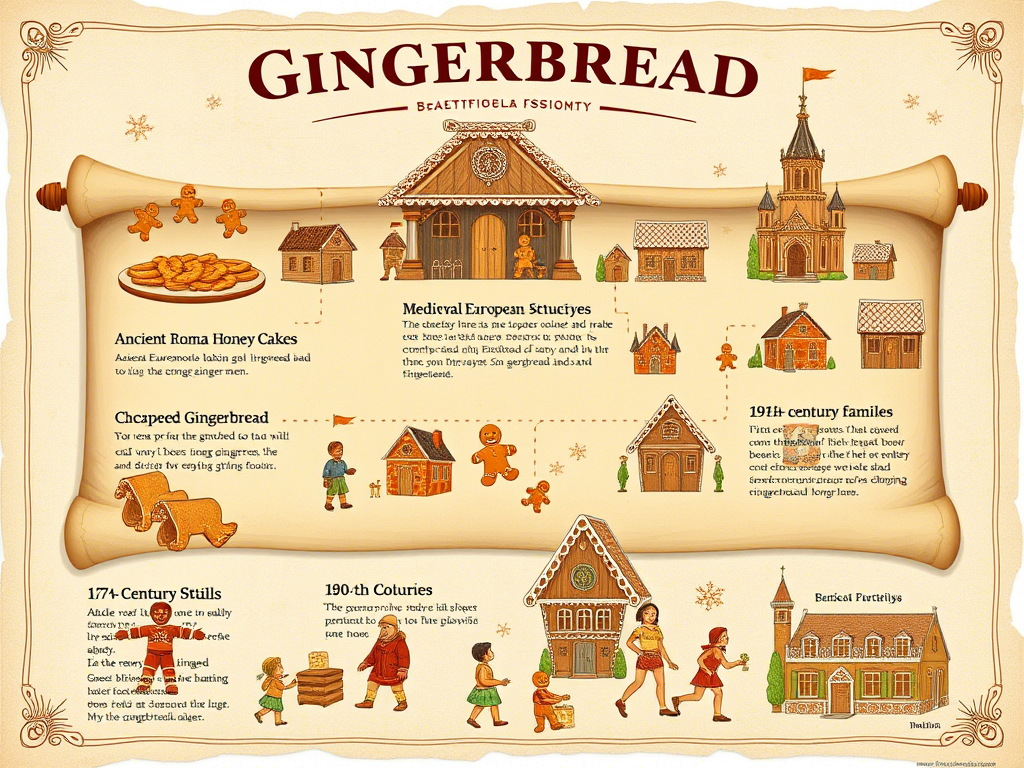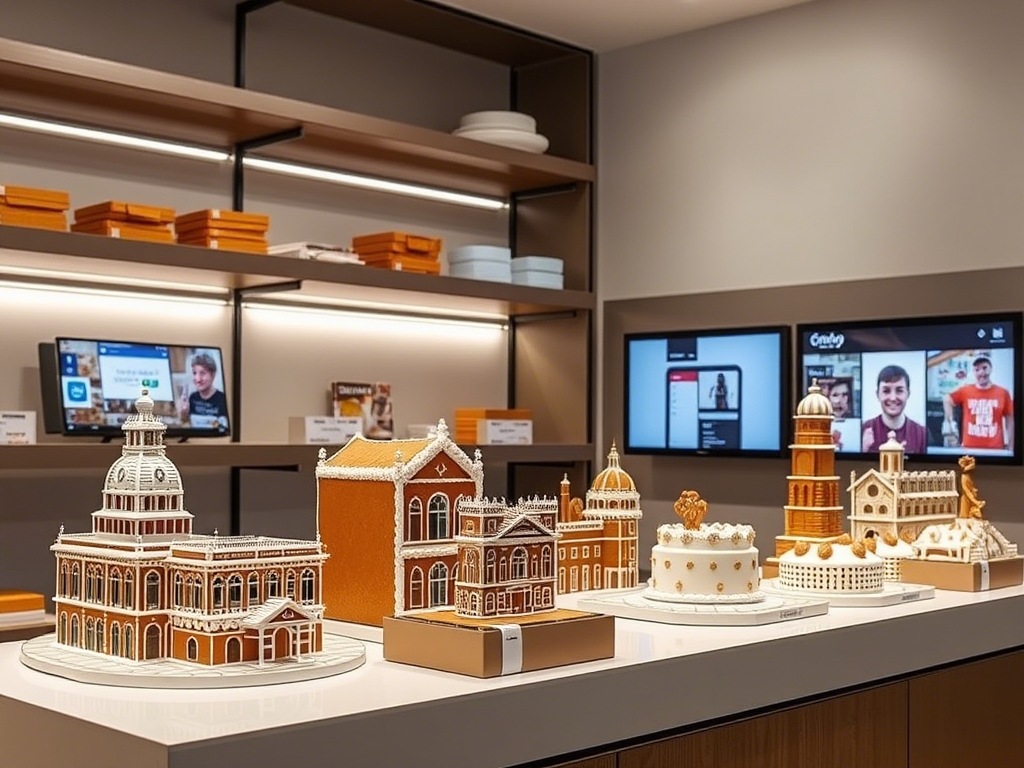Fascinating History & Facts About Gingerbread
A Global Journey Through the Sweet World of Gingerbread Confections
This page features a curated collection of historical insights and intriguing facts about gingerbread—gathered from reputable sources and culinary records over several decades. We regularly update this content with new findings, so please check back often. If you have unique gingerbread history or stories to share, we’d love to hear from you! Contact Gingerbread Bakery USA at 866-396-4829.

What Is Gingerbread?
Gingerbread is a sweet, spiced food typically flavored with ginger and sweetened with honey, molasses, or brown sugar. The texture and style vary across cultures and regions—ranging from soft, cake-like loaves to crisp cookies and decorative biscuits. Regardless of form, all gingerbread recipes share a warm, aromatic profile that makes them a holiday favorite around the world.
Originally, the term gingerbread referred not to the sweet itself, but to preserved ginger. Over time, it evolved to mean a confection made with ginger and a medley of spices.
🌍 Gingerbread Around the World: A Historical Overview
🇫🇷 France: Pain d’Épices
The French term pain d’épices, literally meaning "spice bread," is a traditional version of gingerbread made primarily with honey. Historically, French gingerbread did not contain ginger as a main ingredient.
🇩🇪 Germany: Lebkuchen & Pfefferkuchen
In Germany, gingerbread comes in two primary forms: Lebkuchen – A soft, spiced cake-style gingerbread popular during the holiday season. Pfefferkuchen – A harder version, often found at Christmas markets, decorated with icing and sweets. The city of Nuremberg became renowned as the "Gingerbread Capital of the World" and was home to organized baker guilds as early as the 14th century.
🇸🇪 Sweden & 🇳🇴 Norway: Pepparkakor & Pepperkaker
The Scandinavian form of gingerbread includes: Pepparkakor (Swedish) Pepperkaker (Norwegian) These are thin, crisp cookies often used as Christmas tree or window decorations. It's a cherished family tradition to bake and decorate them during the holidays.
🇨🇭 Switzerland: Biber
In Switzerland, biber is a rectangular gingerbread cake filled with marzipan and adorned with detailed engravings or iced illustrations. It’s especially popular in Appenzell and St. Gallen.
🇵🇱 Poland: Toruń Gingerbread
Poland is famous for pierniki (gingerbreads), with Toruń gingerbread being the most iconic. These confections date back to the Middle Ages and were a favorite treat of composer Frédéric Chopin.
🇧🇷 Brazil: Pão de Mel
In Brazil, pão de mel ("honey bread") is a gingerbread-style cake covered in chocolate. It ranges from bite-sized pieces to full-sized cakes and is enjoyed year-round.
🇳🇱 Netherlands & 🇧🇪 Belgium: Ontbijtkoek
Known as Peperkoek, Kruidkoek, or Ontbijtkoek, this variety is a soft gingerbread loaf often eaten at breakfast with butter.
🇬🇧 United Kingdom: Gingerbread Men & Parkin
In the UK: Gingerbread men were popularized by Queen Elizabeth I, who had them crafted to resemble foreign dignitaries. Parkin is a moist gingerbread cake made with oatmeal and treacle, particularly enjoyed in northern England.
🇷🇺 Russia: Tula Prjaniki
Tula prjaniki is Russia’s most well-known gingerbread, originating in the city of Tula. It is often stamped with intricate designs and filled with jam or sweet fillings.
🇷🇴 Romania: Turtă Dulce
Romanian turtă dulce is typically coated in a sugary glaze, maintaining a firm yet soft texture.
🇧🇬 Bulgaria: Medenka
Bulgaria’s medenka is a palm-sized, chocolate-coated cookie made with honey, cinnamon, and ginger—perfectly embodying Eastern European holiday flavors.
🕰️ How Gingerbread Came to Europe
The first major introduction of gingerbread to Europe is attributed to Gregory of Nicopolis, an Armenian monk who relocated to France in 992 AD. He taught gingerbread baking techniques to local Christians and passed away in 999 AD.
By the 13th century, German immigrants brought gingerbread to Sweden, where it was used both for health and holiday decoration. Early records from Vadstena Abbey show that nuns baked gingerbread to aid digestion as early as 1444.
In 15th century Germany, gingerbread production was regulated by specialized guilds that crafted both edible and decorative confections. By the 17th century, gingerbread was sold in monasteries, pharmacies, and at public markets throughout Europe.
🎅 Gingerbread in the Modern World
Today, gingerbread enjoys global appeal—especially during Christmas. In the United States, it is popular as:
Edible holiday centerpieces
Soft forms are typically referred to as gingerbread cake, while firmer versions are used for cookies or decorative houses.
👑 Fun Fact: The first gingerbread man was allegedly served by Queen Elizabeth I herself!


Summary of Gingerbread Variants by Region
| Country | Local Name | Form | Notable Feature |
|---|---|---|---|
| Germany | Lebkuchen | Soft/Hard | Decorative & often iced |
| Sweden / Norway | Pepparkakor / Pepperkaker | Thin, crisp cookies | Used as window decorations |
| Poland | Pierniki (Toruń) | Stamped, jam-filled | A favorite of Chopin |
| Switzerland | Biber | Marzipan-filled cake | Detailed engravings |
| United Kingdom | Parkin, Gingerbread | Cake/Cookie | Treacle-based or shaped into figures |
| Brazil | Pão de Mel | Chocolate-covered cake | Soft and often bite-sized |
| Netherlands / Belgium | Ontbijtkoek | Soft loaf | Eaten with butter at breakfast |
| Russia | Prjaniki | Soft, stamped biscuits | Originates from Tula |
| Romania | Turtă Dulce | Glazed cookies | Firm, mildly spiced |
| Bulgaria | Medenka | Chocolate-coated cookies | Palm-sized and honey-rich |
Want to Share Gingerbread Knowledge?
If you have historical insights, family recipes, or regional gingerbread traditions to share, we invite you to be a part of this living archive! Contact Gingerbread Bakery USA at 866-396-4829 or email us through our contact page.
Let’s keep the sweet history of gingerbread alive—one delicious story at a time.
From ancient honey cakes to today’s dazzling edible mansions, gingerbread houses have earned their place as a beloved holiday icon. The combination of cozy flavors, handmade detail, and festive tradition make them a magical part of the Christmas season.
Looking to order a custom gingerbread house this year? Make sure you do it early — they’re in high demand!

